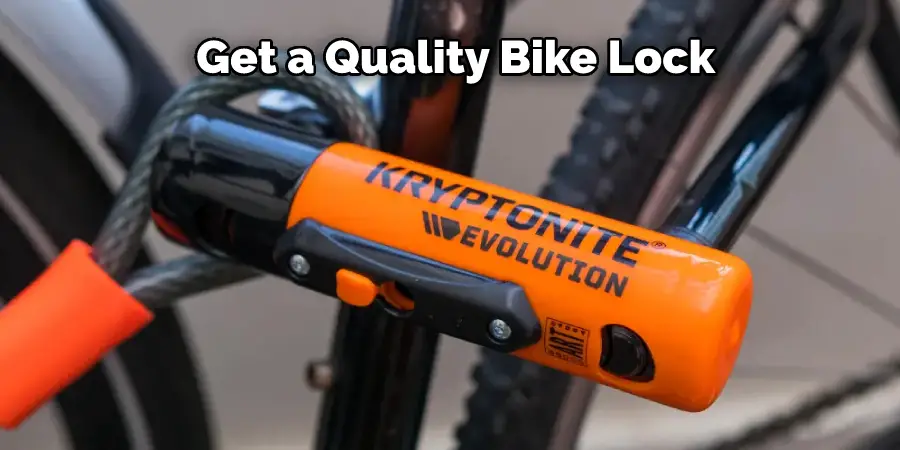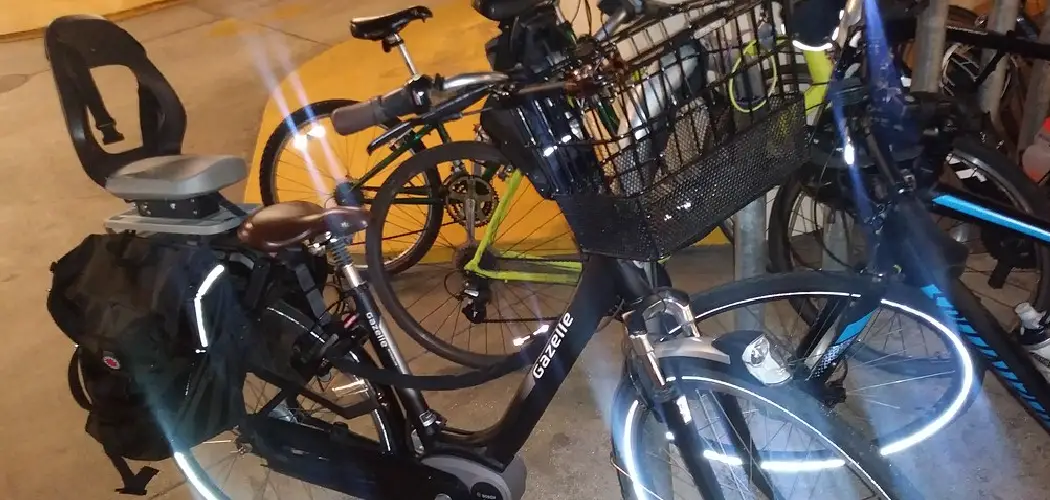Bicycles can be a great way to get around town, but they can also be a hassle to store. If you don’t have a lot of room in your house, storing your bike outdoors or in the garage might be your only option.
But how do you keep it safe from thieves and the weather? Thankfully, there are a few ways to lock up your bike so that it’s secure. In this blog post, we’ll show you how to lock bikes in garage. So whether you’re leaving your bike in the garage or taking it with you on a ride, these tips will help keep it safe. Keep reading to learn more.

Summary: When locking your bike in your garage, you can do a few things to ensure its safety. First, invest in a sturdy and reliable lock. A U-lock or heavy-duty chain lock are good options. Next, anchor your bike to something stationary, such as a robust metal rack or a wall anchor. Make sure the lock is secure and not easily accessible to thieves.
What Causes Bike Theft?
Bike theft is most common in urban areas, with more people and less space. Thieves often target left unlocked or unsecured bikes, making them easy targets. The most common type of bike theft is known as “snatching,” where a thief quickly grabs a bike and runs off with it. This type of theft is often done in busy areas, where the thief can blend in with the crowd. Another type of bike theft is known as “stripping,” where the thief takes apart the bike to sell the parts individually.
This type of theft is more common in rural areas, where there are fewer people around. The other reason bikes are commonly stolen is because they’re valuable. A new bike can cost hundreds or even thousands of dollars, making them a tempting target for thieves. And even if you have an old bike that’s not worth much money, the parts can still be sold for a profit. This is why it’s so important to take steps to secure your bike, even if it’s just in the garage.

10 Ways How to Lock Bikes in Garage
1. Choose a Secure Location:
Select a location within your garage that is both visible and easily accessible, making it more convenient for you to lock and unlock your bike. If possible, choose a spot near a wall or other solid structure that can serve as an anchor point for your lock.
2. Install a Ground or Wall Anchor:
To create a secure anchor point for your bike, install a ground or wall anchor. These heavy-duty anchors are typically made of steel and can be mounted to the floor or wall of your garage. They provide a strong, immovable point to which you can lock your bike.
3. Choose the Right Lock:
There are several types of bike locks available on the market, including chain locks, U-locks, and cable locks. When selecting a lock for your bike, prioritize strength and durability. A high-quality U-lock or chain lock is recommended for added security. Look for locks with a high security rating and features like anti-picking and anti-drilling mechanisms.
4. Secure the Frame and Wheels:
When locking your bike, it’s important to secure both the frame and wheels to the anchor point. This can be achieved by using a combination of a U-lock and a cable or chain lock. First, use the U-lock to secure the bike frame to the anchor point. Then, use the cable or chain lock to loop through both wheels and the U-lock, ensuring all parts of the bike are secured.
5. Lock the Bike to the Anchor Point:
With the frame and wheels secured, attach the lock to the anchor point. If using a U-lock, place the U-shaped shackle around the bike frame, the anchor point, and one wheel if possible. Insert the crossbar and turn the key to lock the device. If using a chain or cable lock, thread the chain or cable through the bike frame, both wheels, and the anchor point, then secure the lock.
6. Use Additional Security Measures:
In addition to a high-quality lock, consider using additional security measures to further protect your bike. This may include using a secondary lock, such as a padlock or a cable lock, to secure other components of the bike, like the seat or handlebars. Another option is to install a security camera or motion sensor light in your garage to deter potential thieves.
7. Store Bikes Vertically:
Storing bikes vertically can save space and make it more difficult for thieves to access them. There are various bike storage solutions available, including wall-mounted hooks and racks, that allow you to hang your bike from the wall or ceiling. This can make it more challenging for a thief to steal your bike without attracting attention.
8. Register Your Bike:
Registering your bike with a national bike registry or your local police department can increase the chances of recovering your bike if it’s stolen. Many registries offer a unique identification number or sticker for your bike, which can be added to the frame as a deterrent to thieves and a means of identification if the bike is recovered.
9. Keep a Record of Your Bike’s Details:
Maintain a record of your bike’s make, model, serial number, and any unique features or markings. This information can be crucial in identifying and recovering your bike if it’s stolen. It’s also helpful to have photos of your bike from different angles to provide to the police or insurance company in case of theft.
10. Secure Garage Doors and Windows:
Finally, ensure your garage is secure by locking doors and windows when not in use. Install sturdy locks on garage doors and consider upgrading to a smart garage door opener that allows you to monitor and control access remotely. Additionally, consider reinforcing garage windows with security film or installing window bars to deter break-ins.
By following these steps, you can significantly reduce the risk of having your bike stolen from your
How Much Should I Spend on a Bike Lock?
The type of bike lock you need depends on the value of your bike, the area you live in, and how often you ride. If you have an expensive bike, live in an urban area, and ride often, you’ll need a higher-quality lock.
If you have a less expensive bike and live in a rural area, you can get away with a lower-quality lock. No matter what type of bike lock you choose, make sure it’s rated by a reputable organization such as the Sold Secure Bicycle Gold standard.
This will ensure that your lock meets the highest security standards. When it comes to price, you’ll get what you pay for. Higher-quality locks will cost more, but they’re worth the investment if you want to keep your bike safe.
Tips and Warnings on How to Lock Bikes in Garage:
Tips:
- Always lock your bike in a garage with a good-quality padlock.
- If possible, chains or cables should be combined with the padlock.
- Make sure the chain or cable is long enough to go around the frame and both wheels of the bike.
- Run the chain or cable through the frame and both wheels of the bike, and then secure it to a solid object like a post or pipe.
- When locking your bike in a garage, always lock the frame to something solid.
- If you have quick-release wheels, remove them and take them with you.
- Consider using a security sticker or engraving your bike with your name or driver’s license number.
Warnings:
- Never leave your bike unlocked in a garage, even for a short period.
- Thieves are opportunistic and will take advantage of any opportunity to steal a bike.
- A locked bike is not 100% secure, but it is much less likely to be stolen than an unlocked bike.
- Always close and lock the garage door when you leave.
Conclusion
So, there you have it! You now know how to lock bikes in garage. If you follow these simple steps, your bike will be safe and secure. We hope you found this article helpful. If you have any questions or comments, please feel free to leave them below. Thanks for reading!
I am Rick. I grew up helping my dad with his handyman service. I learned a lot from him about how to fix things, and also about how to work hard and take care of business. These days, I’m still into fixing things- only now, I’m doing it for a living.
I’m always looking for new ways to help people grow and develop. That’s why I have created this blog to share all my experience and knowledge so
that I can help people who are interested in DIY repair.

